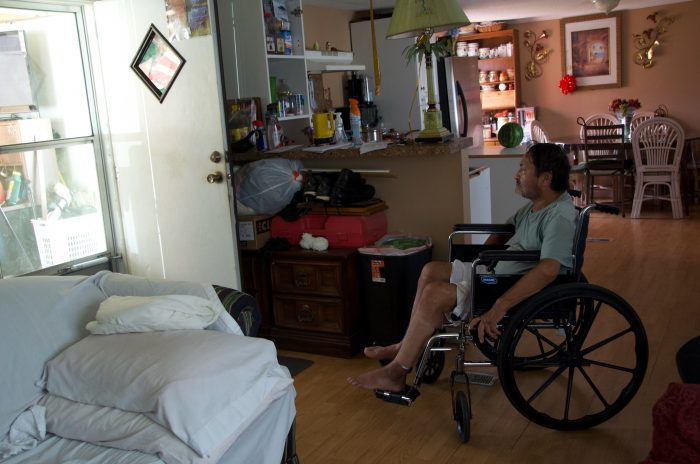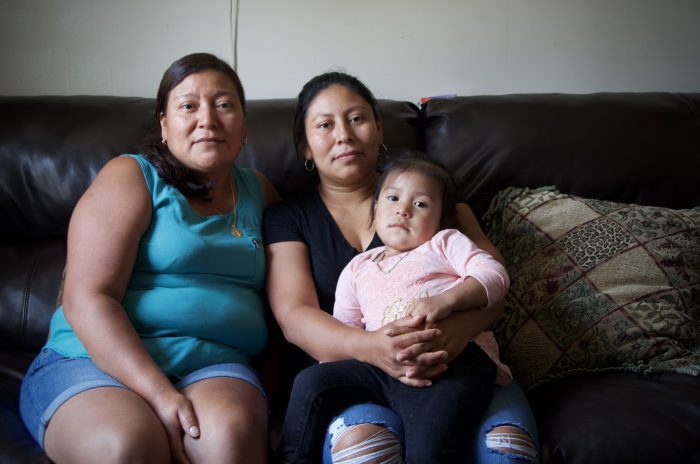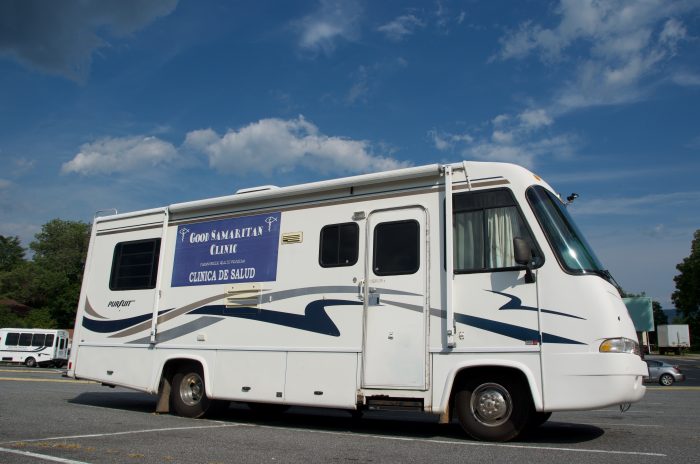Marco Garcia lay on the sheet-covered couch of his mobile home in rural western North Carolina, staring at the ceiling. He longed to be outside in the fields, picking blueberries, tomatoes, and cucumbers, like he’d done the 27 years since he emigrated from Mexico. But he had a diabetic ulcer on his leg, and he couldn’t walk, much less work. Meanwhile, his wife had to earn money to support them both by working in the fields and cleaning houses, all while serving as his primary caretaker.
“I would think, ‘What am I doing in this world?’” said the 57-year-old last summer. “I would get to a point where I would rather die. I felt like I was [of] no use.”
When a health worker at North Carolina Farmworkers Health Program (NCFHP), the organization that had helped Garcia access medical treatment for his leg, offered him the opportunity to speak with a bilingual mental-health therapist by videoconference, he acquiesced, though he had never seen a therapist before and felt nervous and uncomfortable about it.
Garcia pinpoints his second session with a therapist, conducted with the help of the outreach worker via iPad in his living room, as a turning point—and he has since pulled out of his deep depression. The conversation turned to religion, and as a believer in God, that resonated with him. “I started thinking about my life and what I was going through and realized I had faith,” said Garcia, wheelchair bound at the time. “It gave me a lot of strength.”
Many of the 2 to 3 million farmworkers who plant, pick, and process food in the U.S. experience mental health issues. They are isolated on farms, often separated from their families by thousands of miles, living and working under difficult conditions, and facing discrimination and fear due to their undocumented status—situations and stressors that often lead to anxiety, depression, and/or alcohol abuse.
At the same time, farmworkers face many barriers to getting the help they need, including the fact they often live and work far from urban centers and the associated healthcare facilities. In the U.S., in fact, more than 90 percent of psychologists and psychiatrists work exclusively in metropolitan areas, and about 60 percent of rural Americans live in areas with a mental health professional shortage, according to numbers from the Center for Rural Mental Health Research, part of the Western Interstate Commission for Higher Education (WICHE). In addition to the physical distance from providers, farmworkers are also often on the move and lack the time off work, transportation, and health insurance coverage that make pursuing treatment possible.
The new NCFHP farmworker teletherapy program, which provides mental health treatment to agricultural workers in rural reaches of North Carolina, is one of the first of its kind in the U.S.—and its creators are hoping it can become a model for others. Using iPads and hotspots, farmworkers can tele-connect with bilingual therapists at El Futuro, a Durham-based nonprofit clinic that provides mental health services for Latinx families. In the first year, 82 farmworkers took advantage of the program.

Marco Garcia found teletherapy while living with a disabling illness last summer.
The North Carolina effort is part of a larger move toward this new approach. Community health organizations across America are increasingly turning to telehealth as a strategy to serve people in areas that lack providers. According to an analysis of 25 billion privately billed claim records by the nonprofit FAIR Health, the use of telehealth services increased by 643 percent nationally between 2011 and 2016—and 960 percent in rural areas. Mental health services accounted for the top portion, 31 percent, of the telehealth claims in 2016.
NCFHP leaders say the tele-element of their program enables them to reach underserved people in hard-to-reach areas. “Most highly qualified [healthcare] professionals don’t want to live in these small towns,” says Karla Siu, the former clinical director of El Futuro, who wrote the grants to establish the program and worked as a teletherapist for a year. Using virtual therapy, she says, “we can provide the clinical resource without asking the clinician to [move or] travel.”
Laborers in Farm Country
The mental health of farmers has received a lot of attention in recent years—due, at least in part, to incorrect numbers put out (and then retracted) by the Centers for Disease Control (CDC). Media reports in The Guardian, the The New York Times, Newsweek, and NPR called attention to the issue of farmer suicide, and U.S. Senators Jon Tester (D-Montana) and Chuck Grassley (R-Iowa) introduced the Seeding Rural Resilience Act to help cut down on the number of farmers taking their own lives.
Though their mental-health plight receives far less attention, farmworkers face a greater suicide risk higher than farmers do, and rank third among occupational groups in the revised CDC study. Various other studies corroborate the fact that agricultural workers—83 percent of whom are Hispanic, 33 percent of whom live below the poverty level—often struggle with depression and anxiety.
One study of Latinx farmworkers in North Carolina found that 52 percent experience depression and 16.5 percent experience anxiety. Another study of 248 women in Latinx farmworker families also in North Carolina, revealed that 31 percent—almost a third—exhibited significant signs of depression, compared to the 11 percent depression rate among Hispanic women more generally in the U.S. A third study found that 80 percent of women farmworkers in California faced on-the-job sexual harassment, including 24 percent reporting sexual coercion or on-the-job blackmail that affected their physical and psychological health.
“Despite the fact that there is not a lot of data, the data that’s there is very compelling,” says Carlos Ugarte, director of health programs for Farmworker Justice, a national nonprofit that has advocated for farmworker rights since 1981. “It doesn’t take a lot to start putting the pieces together and say, ‘Yeah, this is something we really need to look at.’”
Ugarte says that because farmworkers do not have political or economic clout, unlike some of the other segments of the Latinx population, it can be hard to motivate decision makers to put money toward programs that benefit them. Farmworker mental health, he says, “is not getting enough attention in the national conversation, and it’s not getting enough attention in terms of the investment on the part of agencies, especially within the federal government.”
Trying to Survive, Nothing More
Many farmworkers have faced triple trauma, says Mary Johnson Rockers, who worked more than 10 years as a health operations specialist with NCFHP before becoming the teletherapy program lead for El Futuro, and a tele-mental health provider herself. First, there’s the trauma of corruption, violence, or war in their home country that motivates them to leave; second, there’s the trauma that occurs during migration, as families are separated or people die or fall ill en route; and third, there’s the trauma of arriving in a new country, having to adjust to unfamiliar language and culture and facing hostile, anti-immigrant sentiments.
Sisters Ana Delarosa Castillo, 41, and Reyna Delarosa Castillo, 38, came to the U.S. from Guatemala in 1994 and 1997, respectively, to escape a crushing poverty. They’ve worked in the fields in western North Carolina for the last two decades, for the last four years at a farm owned by a kind woman who treats them well. But that is not the norm.
Sitting on a leather couch of Ana’s home, as Reyna’s two-year-old daughter arranges pieces of orange peel on the tan shag carpet covering a linoleum floor, they describe, in Spanish, their typical work experience.

Ana and Reyna have planted and harvested fruits and vegetables in the fields of North Carolina for the last two decades, working under tough conditions.
As farmworkers, they usually work 7 a.m. to 7 p.m. in the sun, sometimes in oppressive, 90-plus-degree heat, says Reyna, wearing distressed jeans and small silver hoops in her ears. Most farms haven’t provided them with water to drink or bathroom facilities, forcing women to relieve themselves in the presence of their male counterparts, which they say robs them of their dignity.
The sisters describe having to plant tomatoes at breakneck pace on their hands and knees, chasing the tractor carrying the seeds for hours at a time. “The machine doesn’t get tired; it never stops to let us rest our backs,” says Ana, who wears a turquoise tank top and a gold pendant around her neck. “In the moment, you’re trying to survive, nothing more.”
The lack of job security is also a stressor. As year-round residents in their community, the sisters have had trouble securing enough agricultural work because farms in their area have begun to rely more heavily on workers brought to the county on H-2A temporary agricultural work visas. “The work is hard, but we used to be okay with it, because we felt secure in our jobs,” Reyna says. “We don’t have that anymore.”
(H-2A workers face their own set of problems. Because they are tied to a single employer and live in farm-supplied housing, they can’t leave if living or working conditions are bad, and they often grow depressed from the extreme isolation and separation from their families.)
The hostile nature of the current political climate also causes the sisters stress. In August, Immigrant and Customs Enforcement (ICE) agents arrested five workers at the local Case Farms chicken processing plant, and Reyna says she is afraid to leave the house to go grocery shopping or take her children to school. “I feel like I’m in a jail,” she says tearfully.
While an outreach worker visiting a farm Ana was working on recommended that she speak with a therapist during a rough patch she went through a few months ago—and Ana was interested—she hasn’t managed to line up treatment yet. She would like to if things get hard again, and Reyna agrees. “It would be nice for someone to listen,” Reyna says. “You’re working a hard job, you’re going through a lot. To have someone listen and guide you to the right thing would be good.”
Creating a Model and Fighting a Stigma
For the last 26 years, NCFHP has worked with local agencies and health centers across the state to connect farmworkers and their families with medical and dental care. In addition to seeing farmworkers in 10 designated brick-and-mortar clinics, NCFHP sends outreach workers and doctors in medically equipped mobile units to visit farmworker camps in rural areas.
The program has historically mainly focused on physical ailments, but after farmworkers indicated a desire for mental health services in feedback surveys, NCFHP teamed up with El Futuro. With the help of funding from the Health Resources and Services Administration (HRSA), they began offering teletherapy in January 2019. While they started out of the Good Samaritan Clinic, a NCFHP-associated clinic in the western part of the state, they have since expanded to a second, larger clinic in the east. “We saw mental health as whole-person health, a very important part of someone’s well-being,” Rockers says.

The Good Samaritan Clinic’s mobile unit, which visits farmworker camps in rural areas and provides medical services and teletherapy.
Now, the NCFHP outreach workers incorporate mental health questions into their health assessments. If the patient appears to be experiencing anxiety or depression, they are typically set up with a teletherapy appointment the as soon as possible. To give a picture, when the mobile medical unit pulls into a farmworker camp 40 minutes from its home base on a given Tuesday evening, six or seven of the 150 workers there might receive a private, iPad-enabled therapy session as part of their treatment plan.
NCFHP leaders have had to overcome some cultural barriers—namely, the stigma associated with therapy—in getting the teletherapy program off the ground. “In my country, usually you don’t see a psychiatrist unless you are a little off,” said Christian Ramazzini, who is from Guatemala and worked as the NCFHP outreach coordinator based out of the Good Samaritan Clinic for seven years until last summer, helping get the clinic’s teletherapy program off the ground. “We’re trying to fight that cultural piece and convince people you don’t have to be crazy to seek services.”
The program has a couple factors working in its favor, however. First, integrating mental health into primary care makes it feel like less of a leap, Ramazzini says. And second, the trust the outreach workers have built up with the farmworkers they serve makes the workers more accepting of their offerings. “We have great relationships with most of our patients,” Ramazzini says. “They’re pretty open to telling us what’s going on in their lives.”
Telehealth as a Tool

Mary Johnson Rockers, the teletherapy program lead for El Futuro, who currently works as a full-time teletherapist for the nonprofit.
While most farmworkers trust the caseworkers they have grown to know, teletherapy enables them to share their issues and feelings with someone they are assured not to encounter on a day-to-day basis. “Most of the mental health issues they’re having, they can’t share with their sons or cousins or moms or whoever is close to them,” Ramazzini says. “Even sometimes in the clinic, they might feel a little funky, because the community is so small.”
Still, despite its benefits, teletherapy as a method hasn’t made headway in all organizations serving farmworkers. While Finger Lakes Community Health in New York offers the farmworkers it serves the option to see specialists through its telehealth program, others, like Farmworker Justice, are slower to jump on the digital bandwagon because they lack the funds, and because they want to better understand the approach.
“I feel there [are questions to be answered] as to what is the best way to apply this fantastic, cutting-edge technology in farmworker communities,” says Farmworker Justice’s Ugarte. He wants to be sure any telehealth programs the organization supports are culturally sensitive and designed to be impactful, sustainable, and scalable. “The work going on in North Carolina and other places is going to help inform that,” he says.
In an effort to address mental health concerns in farming communities, many of whom are facing tough economic times and the stress that comes from extreme weather and natural disasters, the 2018 Farm Bill authorized the Farm and Ranch Stress Assistance Network (FRSAN), a bipartisan program that will create a national network of stress-assistance services—things like farm hotlines, support groups, workshops, and in-home assistance—for people working in agriculture.
Matt Perdue, who worked on farmer mental health with the National Farmers Union, which pushed the network, before taking a job with the North Dakota Farmers Union in November, says the Farmers Union wants to support the mental health of everyone in agricultural communities, including farmworkers. As the agricultural mental health network gets built over the next few years, Perdue says, “We see telehealth as being a very important part of the puzzle.” At the same time, he added, “We need to maintain—and probably sharpen—the focus on the farmworker community.”
Sometimes, You Just Need Help
Most of the farmworkers in the North Carolina program are dealing with issues related to anxiety, depression, and substance abuse. While the traditional psychotherapy model consists of repeated sessions that dig into root causes, the mental health providers serving farmworkers rely on a targeted approach, seeing each farmworker an average of three times.
“Quite frankly, we never know when we’re going to see our patient next,” El Futuro’s Siu says. Rather than establishing a relationship over the standard eight to 12-sessions, she and her colleagues focus only on the complaint the patient comes in with. “It’s been really empowering for all of us, because we have these really productive 30- to 45-minute conversations,” she says.
Luke Smith, executive director of El Futuro, also sees the power of the interactions, despite their limited nature. “Even one conversation can be affirming, validating, and supportive in a time when that’s just what you need,” he says. “You’re providing a space and humanity for someone who hasn’t felt that very much. That can bring somebody out of that pit of despair.”
One woman Siu worked with, she recalls, had experienced a traumatic incident and came to her first session feeling depressed, anxious, and immobilized—terrified to leave her house. “After five sessions, she was excited to tell me that she’s recovered functioning, and she was serving and volunteering again in her church and her community,” Siu said. “Honestly, I wasn’t expecting we could accomplish that in such a short time.”
The majority of patients seen through the Good Samaritan Clinic have been women, Ramazzini says. “I’m not saying that women have more mental health issues,” he says. “I’m saying men are not likely to have appointments in general; that’s the same for diabetes and every chronic disease we treat—men don’t come to the doctor until they have to go to the hospital. There’s a culture behind that.”
So far, Ramazzini has seen teletherapy be transformative for many of the farmworkers he works with. “A guy I spoke with yesterday said, ‘I had a knot in my chest when I came in to receive services, and I don’t feel it anymore,’” the former outreach worker said last summer.
In fact, he goes so far as to say fewer patients would be alive today without the teletherapy service. One farmworker he worked with had been raped and wanted to take his own life, Ramazzini remembers, and he was able to connect the man with a therapist and alter his course. His staff have also spoken to several farmworkers at moments they were considering committing suicide. “If there are 10 patients in the last three or four months that want to commit suicide, it’s very likely one of them would have if we were not providing these services,” says Ramazzini.
After his second therapy session, Marco Garcia started praying more. He began to watch religious DVDs—Ten Commandments, The Bible by Charlton Heston, La Fé de Jesus—on the Panasonic television at the end of his couch, and they fortify him. Garcia credits the therapy session he received at his lowest point for his renewed inner strength and sense of hope. “I didn’t want to look for help, but at the same time, I was desperate,” he said. “Sometimes you just need help to get pointed in the right direction.”
Siu said she’s constantly inspired by her farmworker patients, who she describes as driven, hard-working, humble, and grounded. “This is valuable and important work, strengthening this community that serves our larger society in such a core and central way, by providing our food,” she said. “It’s the least we could do.”
The farmworkers names have been changed.
Photos by Christina Cooke.